DOI:
10.1039/D3RA07779A
(Paper)
RSC Adv., 2024,
14, 7414-7429
Effects of different heat treatment media on odorous constituents, chemical decomposition and mechanical properties of two hardwoods
Received
14th November 2023
, Accepted 20th January 2024
First published on 1st March 2024
Abstract
With China's increasing dependence on foreign wood, African wood has gradually become a potential imported species, but its use is seriously affected by problems such as unpleasant odors. In this study, we investigate the effect of heat treatment medium on odor-causing VOCs, decomposition of structural polymers, Modulus of Rupture (MOR) and Modulus of Elasticity (MOE) of hardwood. Samples of “Afrormosia” and “Newtonia” wood were heated under air and palm oil for two hours at 160 °C, 180 °C, and 200 °C, respectively. Then, the nature of the odor of each VOC emitted by the wood before and after heat treatment was identified using the GCMS method. The decomposition of hemicelluloses, cellulose and lignin in wood samples was examined using a ThermoGravimetric Analyzer coupled to Fourier Transform InfraRed spectrometry (TGA-FTIR). The 3-point bending test was used to evaluate MOR and MOE. The results indicate that the main VOCs responsible for unpleasant smells are acetic acid and hexanal; the reduction in hexanal emissions after heat treatment is mainly due to the treatment temperature, while the reduction in acetic acid emissions depends on the heat treatment medium and is due to the chemical interactions between palm oil and acetic acid; thus, the heat treatment under palm oil reduces the percentage area of VOCs with unpleasant odors in Afrormosia and Newtonia wood better than the heat treatment under air. Based on TGA-3D FTIR analysis and mechanical results, the reduction in MOR is greater in heat treatment under air because the said treatment induces a greater loss of woody matter, which was characterized by higher H2O and CO emissions during heat treatment of wood under palm oil than during heat treatment of wood under air. On the other hand, palm oil more than air, promotes lignin deacetylation, which is characterized by the fact that the 1050 cm−1 wavelength peak was far higher in samples treated with palm oil than in those treated under air; and this might explain why heat treatment under palm oil reduces MOE more than heat treatment under air.
1. Introduction
Afrormosia (Pericopsis elata Van Meeuwen) and Newtonia (Newtonia paucijuga Harms) are two species of wood in the Fabaceae family that grow mainly in tropical Africa. Afrormosia and Newtonia have good physical and aesthetic qualities, justifying their use in a wide range of applications, including shipbuilding, joinery, cabinet-making and exterior cladding.1 However, they both present the problem of unpleasant odors. The consideration of odor when using wood is very important because wood that emits unpleasant odors can affect the quality of humans' lives. Liu and Little2 have proposed to consider formaldehyde and its derivatives as the reference compounds for the evaluation of wood odor quality. According to them, formaldehyde and its derivatives are the organic compounds frequently identified inside houses and responsible not only for unpleasant odors but also for health problems of respiratory origin. Huang et al.3 completed this idea by showing that most of the unpleasant odors of wood are part of the aldehydes and esters. They then proposed heat treatment as one of the ways to reduce unpleasant odors in wood and justified this by pointing out the ability of heat to cut the long chains of structural polymers in wood into smaller molecules. The effects of treatment temperature and wood species on emissions of the constituent odors have been studied,4–6 and results showed that the amount of aldehydes emitted by wood during the heat treatment, especially hexanal and pentanal increases with the heat treatment temperature. On the other hand, heat treatment is likely to alter the mechanical behavior of the material. For this reason, if heat treatment is to be used to improve the wood's odor quality, it must be ensured that it is carried out under conditions that guarantee the wood's mechanical stability. Indeed, some authors have proved that the temperature and treatment time are the two fundamental parameters that determine the variation in the mechanical properties of wood due to heat.7,8 For Kacíková et al.,9 the MOE value remains constant up to treatment temperatures equal to 160 °C, and it is only from the latter value onwards that a significant decrease in MOE is observed, while only temperatures greater than or equal to 220 °C cause a drastic decrease in MOE; these conclusions are also shared by Zhou et al.10 However, some authors11–13 have reported an increase in MOE for wood treated at 160 °C and 200 °C for two and three hours, respectively, and this result is more accentuated as the initial moisture content of the wood decreases. Clearly, this last parameter is just as important as temperature and treatment time. Indeed, Borrega and Kärenlampi14 investigated the effect of moisture content on the mechanical behavior of heat-treated wood and found that wood with a relative humidity close to anhydrous and low mass losses of the order of 2 to 3% showed an improvement in MOR, especially for samples treated for two hours. It also appears that wood species and the direction of fibers greatly influence the effect of heat treatment on mechanical properties. Indeed, angiosperms tend to experience small reductions in MOE compared to those observed in gymnosperms subjected to the same treatment conditions,15 just as MOR and MOE values are generally higher in the radial direction compared to values measured in the tangential direction.16,17 Hao et al.18 have shown that the decrease in mechanical strength of wood is linked to the decrease in hemicelluloses and cellulose in the wood, while the relative increase in MOE is linked to the increase in lignin. Finally, Xu et al.19 have shown that it is possible to reach the above conclusions by coupling TGA and FTIR methods, with the added advantage of gaining information on the temporal evolution of wood structural polymers during wood heat treatment. It's obvious from the above that information on the nature of the VOCs responsible for the unpleasant odors emitted by wood during the heat treatment, as well as information on the main parameters conditioning the influence of heat treatment on the MOE and MOR of wood, are well known. However, few studies have focused on the effect of heat treatment media on VOCs emitted after heat treatment and responsible for unpleasant wood odors. Furthermore, in this study, TGA-FTIR analysis is used to explain, on the basis of wood chemical decomposition, the effect of treatment medium on MOR and MOE variations during wood heat treatment.
2. Materials and methods
2.1. Sample preparation
Afrormosia and Newtonia logs with diameters of around 75 cm were quarter-sawn to obtain boards. Only the boards taken from the heartwood were selected for the experiments. These boards had an initial moisture content of around 65% and were dried in an oven until the moisture content was reduced to 12%, then wrapped in transparent plastic paper and conditioned in the laboratory for several weeks. After conditioning, these boards were sawn parallel to the wood fibers and then transversely to obtain samples with dimensions of 7 mm × 7 mm × 7 mm (L × T × R) for VOCs study and 300 mm × 20 mm × 20 mm (L × T × R) for mechanical tests (Fig. 1). The samples were dried again in a kiln at 103 ± 2 °C to the anhydrous state before heat treatments carried out under air or palm oil at 160 °C, 180 °C, and 200 °C for two hours.
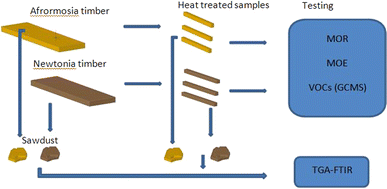 |
| | Fig. 1 Diagram of wood thermal experiment. | |
2.2. Heat treatment
Heat treatment of the wood samples under air was carried out in an oven, while heat treatment under palm oil was carried out in a sealed, homemade heat treatment tank. This tank was covered on the outside with thermal insulation panels to prevent significant heat loss. Afromosia and Newtonia samples for each treatment medium were heat treated at 160 °C, 180 °C, and 200 °C for 2 hours. The wood samples were completely immersed in palm oil during heat treatment.
2.3. VOCs extraction method before and after heat treatment
In order to measure the VOCs emitted by the woods before heat treatment, 08 untreated Afrormosia and 08 untreated Newtonia samples of dimensions 7 mm × 7 mm × 7 mm (L × T × R) were placed in 15 mL headspace bottles for two months. Similarly, immediately after each case of heat treatment, cubic samples of dimensions 7 mm × 7 mm × 7 mm were placed and stored in 15 mL headspace vials for two months. During these two months, the gases emitted by the wood samples remained trapped in these flasks, which were then placed in a water bath at 45 °C for 30 minutes for the extraction of said gases, which have been analyzed by GCMS.
2.4. VOC measurement: GCMS
VOCs released by wood before and after heat treatment were measured using a Shimadzu GCMS-QP2010 Ultra Gas Chromatograph and Mass Spectrometer, Shimadzu, Japan. The extracted gas was inserted into the GC-MS inlet by manual injection and desorbed for 5 min. The temperature of the chromatographic column was progressively increased as follows: (i) 45 °C for 10 min; (ii) raised to 100 °C at a rate of 3 °C min−1 and held for 1 min; (iii) raised to 150 °C at a rate of 5 °C min−1 and held for 5 min; (iv) raised to 250 °C at a rate of 10 °C min−1 and held for 20 min. Helium was used as the carrier gas, with a flow rate of 1 mL min−1 (100![[thin space (1/6-em)]](https://www.rsc.org/images/entities/char_2009.gif) :
:![[thin space (1/6-em)]](https://www.rsc.org/images/entities/char_2009.gif) 1) and an EI power and electron energy of 70 eV. The mass range that has been used for the mass selective detector is 45–400 m/z. The chromatograms obtained were compared to those in the NIST 2011 database to determine the categories and proportions of the related compounds. For this purpose, two main parameters were used: the retention time (RT) and the percentage of peak area (% A).
1) and an EI power and electron energy of 70 eV. The mass range that has been used for the mass selective detector is 45–400 m/z. The chromatograms obtained were compared to those in the NIST 2011 database to determine the categories and proportions of the related compounds. For this purpose, two main parameters were used: the retention time (RT) and the percentage of peak area (% A).
2.5. Description of VOCs odor
The nature of the odor of each VOC emitted by the wood before and after heat treatment was identified using the databases of The Good Scents Company and the database of the National Center for Biotechnology Information Advances Science and Health. These databases have been developed in compliance with the ACS international odor standard for chemical compounds. These databases were used to categorize the VOCs according to their odors into two classes, i.e., “pleasant (p)” and “unpleasant (u)”. Then, the effect of heat treatment on the VOCs with the highest area percentages and classified as having unpleasant smells has been evaluated; thus, if after heat treatment there was a decrease in their area percentage, this treatment was considered to have a positive effect on wood odor, and if not, the effect was considered to be negative.
2.6. TGA-FTIR
For TGA-FTIR analysis, anhydrous Afrormosia and Newtonia sawdust with dimensions of less than 3 mm has been used; four samples were prepared, two of them were representative of air-treated Afrormosia and Newtonia, while two had been mixed with palm oil and were representative of Afrormosia and Newtonia heat-treated with palm oil. To carry out the thermogravimetric analyses, a thermogravimetric analyzer (Nietzsche STA449F3, Germany) operated at a heating rate of 20 °C min−1 was coupled with a Fourier transform infrared spectrometer (Thermo Fisher Scientific, Waltham, MA, USA). 32 scans were performed for each sample and were recorded in the range of 4000 cm−1 to 400 cm−1 with a resolution of 4 cm−1 in transmission mode. For each wood sample, three temperatures were chosen: 160 °C, 180 °C, and 200 °C. The holding time and flow rate of carrier gas were respectively set at 1 hour, 30 minutes and (40 mL min−1).
2.7. Mechanical properties
14 sample groups, each containing 10 specimens, were prepared; the modulus of elasticity (MOE) and modulus of rupture (MOR) were tested in 3-point bending in both radial and tangential directions. The standard used for the mechanical tests is the Chinese standard GB/T 1927.8-2021.
2.8. Statistical analysis
The statistical analyses were completed using IBM SPSS Statistics 21 software. To evaluate the influence of a heat treatment parameter on the mechanical parameters measured in several groups of samples from the wood treated, the averages of the parameters of each batch were calculated and compared using the Student's t-test for independent samples with a percentage confidence interval equal to 95%.
3. Results and discussion
3.1. Effect of heat treatment on the odor of Afrormosia and Newtonia
Hexanal is the main VOC responsible for the unpleasant odors of Afrormosia, as its percentage area alone represents 43.36% of the total percentage area of VOCs emitted.4,20 Heat treatment of Afrormosia under air significantly reduced aldehydes with unpleasant odors (Table 1). A reduction of about 89% for the treatments under air at 160 °C and 180 °C and of about 99% for the treatment under air at 200 °C was found. In fact, the cumulative percentage area of aldehydes emitted before the heat treatment of Afrormosia under air and endowed with unpleasant odors was 46.17%; after treatment at 200 °C, it was only 0.14% (Fig. 2). This drastic drop is due to the evolution of the hexanal content of the VOCs emitted by Afrormosia (Table 1). Hexanal, which represented about 76% of the aldehydes emitted by untreated Afrormosia, showed a significant reduction with temperature. Heat treatment of Afrormosia wood with palm oil better reduced the emission of hexanal than air heat treatment (Table 1). The palm oil heat treatments at 160 °C, 180 °C and 200 °C reduced the emission rates of the unpleasant-smelling esters from Afrormosia better than the heat treatments under air. Indeed, the percentages of reduction for the first case were respectively 18.67% and 17.70% and 80.10% (Fig. 2); while the heat treatment under air of Afrormosia at 160 °C and 180 °C reduced the emission of esters with unpleasant odors, respectively, by 18.66% and 17.70% but at 200 °C, a large increase in the emission of the esters in question was observed. This increase is caused by the acetic acid, [bis[(trimethylsilyl)oxy]phosphinyl]-, trimethylsilyl ester, which is the major ester involved in the emission of unpleasant odors by Afrormosia. Hexanal is found in untreated wood and this is due to the chemical oxidation of wood while drying prior to heat treatment.20 Hexanal is emitted before heat treatment, but regardless of the heat treatment medium (air or palm oil), it is practically not emitted during21 and after heat treatment carried out at 160 °C, 180 °C and 200 °C (Table 1). This leads us to assert that hexanal molecules present in wood fragment under the effect of high temperatures,3 which explains their absence in VOC emissions after heat treatment. Similarly, acetic acid is emitted by Afrormosia before, during21 and after heat treatment under air. On the other hand, acetic acid is not emitted during and after heat treatment of Afrormosia with palm oil (Table 1), in addition, palm oil heated to 160 °C, 180 °C and 200 °C does not emit acetic acid.21 We therefore conclude that acetic acid comes mainly from the degradation of wood structural polymers and in the case of heat treatment with palm oil, acetic acid interacts chemically with palm oil to produce new compounds22 with different odors.
Table 1 Emissions of the main VOCs responsible for Afrormosia unpleasant odors before and after heat treatment
| Control samples |
| Chemical compound |
RT |
% A A |
Chemical classes |
| Hexanal |
3.64 |
43.36 |
Aldehydes |
| Acetic acid, [bis[(trimethylsilyl)oxy]phosphinyl]-, trimethylsilyl ester |
33.37 |
6.03 |
Esters |
| 2-Octenal, (E)- |
20.08 |
2.10 |
Aldehydes |
| Chemical compound |
RT |
% A A-air |
% A A-oil |
Chemical classes |
| Heat treatment at 160 °C |
| Acetic acid, [bis[(trimethylsilyl)oxy]phosphinyl]-, trimethylsilyl ester |
33.33 |
6.29 |
— |
Esters |
| Tetradecane |
32.99 |
6.10 |
1.15 |
Alkanes |
| Hexanal |
3.74 |
5.26 |
4.02 |
Aldehydes |
![[thin space (1/6-em)]](https://www.rsc.org/images/entities/char_2009.gif) |
| Heat treatment at 180 °C |
| Tetradecane |
32.98 |
5.09 |
2.73 |
Alkanes |
| 2-Nonenal, (E)- |
31.23 |
2.98 |
— |
Aldehydes |
| Acetic acid, [bis[(trimethylsilyl)oxy]phosphinyl]-, trimethylsilyl ester |
33.32 |
2.89 |
— |
Esters |
| 2-Octenal, (E)- |
20.08 |
1.47 |
— |
Aldehydes |
![[thin space (1/6-em)]](https://www.rsc.org/images/entities/char_2009.gif) |
| Heat treatment at 200 °C |
| Acetic acid, [bis[(trimethylsilyl)oxy]phosphinyl]-, trimethylsilyl ester |
33.32 |
15.5 |
— |
Esters |
| Tetradecane |
32.98 |
0.87 |
2.72 |
Alkanes |
 |
| | Fig. 2 Emission of the compounds responsible for unpleasant odors from Afrormosia (A) before (b) and after (a) heat treatment under air (left) and under palm oil (right). | |
Heat treatment of Newtonia wood under air conditions does not significantly reduce emissions of aldehydes, esters, furans, alkenes and ketones responsible for unpleasant odors (Fig. 3). Untreated Newtonia emitted practically no aldehyde having an unpleasant odor (Table 2). But during the heat treatment under palm oil of this wood, some aldehydes with undesirable odors were emitted in small quantities, notably pentadecanal which was emitted with a percentage area of 0.37% after the treatment at 160 °C, and 2-decenal (E)- which was emitted with percentage areas of 2.22% and 1.37%, respectively, after the treatments performed at 180 °C and 200 °C. The most remarkable result concerns esters; indeed, Acetic acid, [bis[(trimethylsilyl)oxy]phosphinyl]-, trimethylsilyl ester, which is the main cause of undesirable odors due to esters,23 stopped being emitted after each case of heat treatment under palm oil (Table 2); and this resulted in a reduction of undesirable ester emissions by 77.46%, 92.79%, and 98.20%, respectively, for the Newtonia wood heat treatments performed at 160 °C, 180 °C, and 200 °C. Reduction in the percentage area of acetic acid, [bis[(trimethylsilyl)oxy]phosphinyl]-, trimethylsilyl ester is due to temperature-induced chemical interactions between this compound and palm oil.21
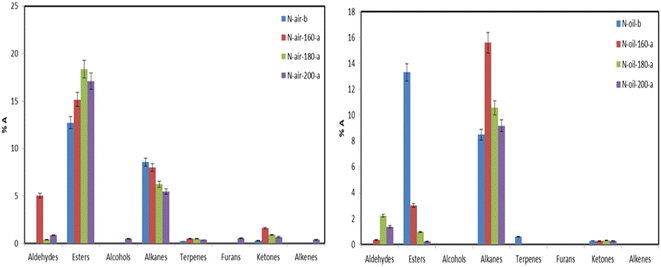 |
| | Fig. 3 Emission of the compounds responsible for unpleasant odors from Newtonia (N) before (b) and after (a) heat treatment under air (left) and under palm oil (right). | |
Table 2 Emissions of the main VOCs responsible for Newtonia unpleasant odors before and after heat treatment
| Control samples |
| Chemical compound |
RT |
% A A |
Chemical classes |
| Acetic acid, [bis[(trimethylsilyl)oxy]phosphinyl]-, trimethylsilyl ester |
33.37 |
12.24 |
Esters |
| Tetradecane |
20.08 |
4.41 |
Aldehydes |
| Chemical compound |
RT |
% A A-air |
% A A-oil |
Chemical classes |
| Heat treatment at 160 °C |
| Acetic acid, [bis[(trimethylsilyl)oxy]phosphinyl]-, trimethylsilyl ester |
33.33 |
13.72 |
— |
Esters |
| Tetradecane |
32.99 |
3.16 |
9.57 |
Alkanes |
| Hexanal |
3.74 |
4.84 |
— |
Aldehydes |
| Dodecane |
28.17 |
1.77 |
4.26 |
Alkanes |
![[thin space (1/6-em)]](https://www.rsc.org/images/entities/char_2009.gif) |
| Heat treatment at 180 °C |
| Acetic acid, [bis[(trimethylsilyl)oxy]phosphinyl]-, trimethylsilyl ester |
33.32 |
14.08 |
— |
Esters |
| 9-Decenoic acid, 2,4-dimethyl-, methyl ester, (R,R)-(−)- |
30.06 |
3.37 |
— |
Aldehydes |
| Dodecane |
28.17 |
1.14 |
3.22 |
Alkanes |
| Tetradecane |
32.98 |
2.23 |
6.08 |
Alkanes |
![[thin space (1/6-em)]](https://www.rsc.org/images/entities/char_2009.gif) |
| Heat treatment at 200 °C |
| Acetic acid, [bis[(trimethylsilyl)oxy]phosphinyl]-, trimethylsilyl ester |
33.32 |
15.23 |
— |
Esters |
| Tetradecane |
32.98 |
2.09 |
5.51 |
Alkanes |
| Dodecane |
28.17 |
0.95 |
2.88 |
Alkanes |
3.2. Effect of heat treatment on the decomposition of wood
3.2.1. TGA and DTA. The residual mass at the end of the transient and steady-state regimes for Afrormosia and Newtonia wood decreases in proportion to the increase in treatment temperature (Fig. 4 and 5). The curve representing the rate of mass loss (DTA) of wood during heat treatment in air has 5 parts (Fig. 4(1) and 5(1)). Part AB, marked by rapid growth in DTA up to the optimum at B, characterizes the phase of wood drying and loss of extractive.19 From point B onwards, the DTA decreases until it reaches a second optimum at point C; this can be explained by the fact that from point B onwards, the retification phenomenon (degradation of wood at low temperature) becomes more prevalent than drying, hence the change in slope of the DTA at point B. Moreover, analysis of Fig. 4–6 shows that the temperature at which the retification phenomenon becomes more prevalent varies between 137 °C and 145 °C.24 This temperature interval is around 400 seconds (Fig. 6), which corresponds to the optimum of the curve for the rate of mass reduction of the wood sample (Fig. 4 and 5). Furthermore, the decrease in mass loss due to dehydration corresponds to the increase in mass loss due to retification, which is why the wood mass loss curve (TG) maintains the same slope until the steady state is reached, while the slope AB, which evolves in the opposite direction to BC, remains approximately equal in absolute value to the slope BC. From point C, the retification phenomenon begins to decrease until point D, then increases slightly until point E, before stabilizing until the end of the heat treatment marked by point F. The CE phase is the transition from the transient (heat treatment phase during which the flux is kept constant at the wood surface) to the permanent regime (heat treatment phase during which the temperature is kept constant at the wood surface); the EF phase is the permanent phase. This phase is characterized by a logarithmic evolution of the wood's TG curve, unlike the transient phase, whose evolution is rather linear.25
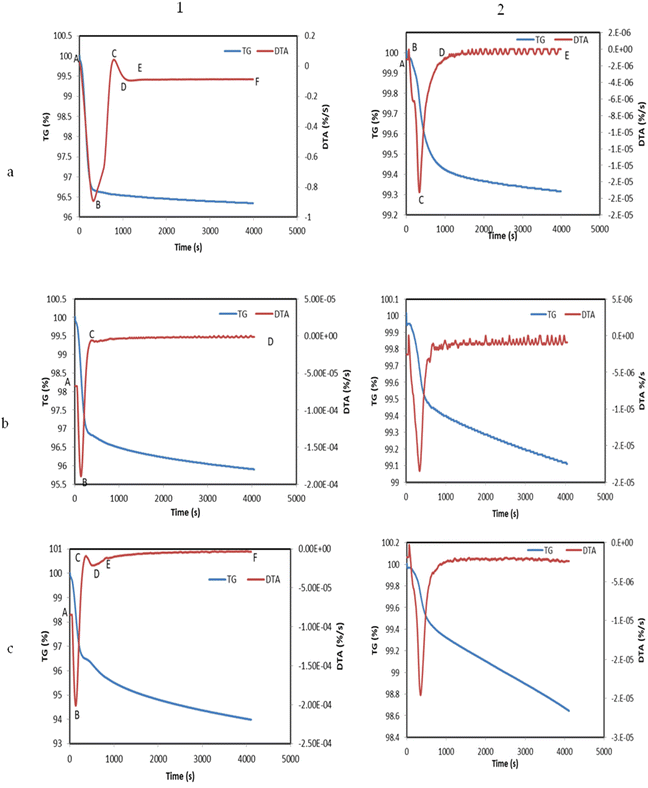 |
| | Fig. 4 ThermoGravimetry Analysis (TGA) and Derivative Thermogravimetry Analysis (DTA) of Afrormosia heat-treated under air (1) and under palm oil (2) (a) 160 °C, (b) 180 °C, (c) 200 °C. | |
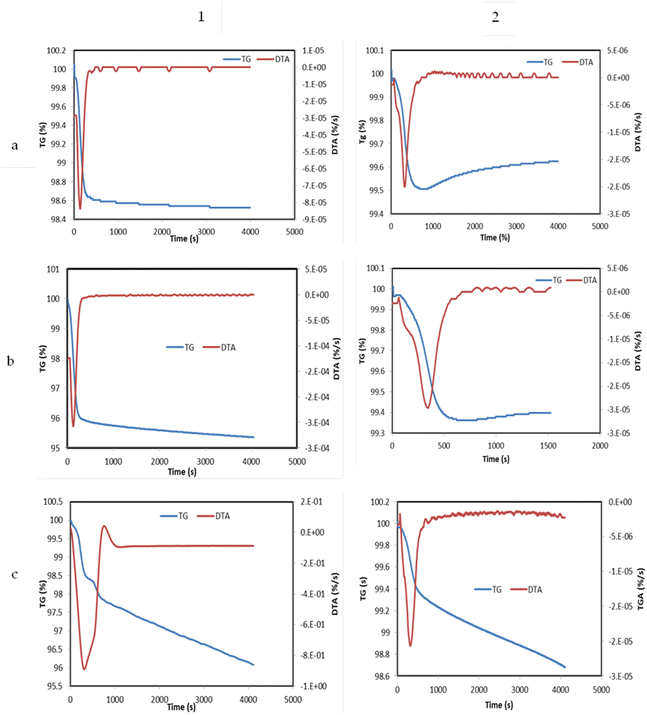 |
| | Fig. 5 ThermoGravimetry Analysis (TGA) and Derivative Thermogravimetry Analysis (DTA) of Newtonia heat-treated under air (1) and under palm oil (2) (a) 160 °C, (b) 180 °C, (c) 200 °C. | |
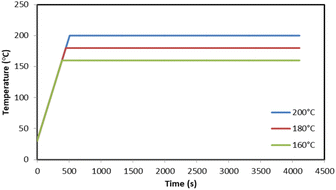 |
| | Fig. 6 Temperature trends during TG experiment. | |
The curve representing the rate of mass loss (DTA) of wood during heat treatment under palm oil has 4 parts (Fig. 4(2) and 5(2)). Phase AB, at the start of the heat treatment, is the phase during which the wood absorbs the palm oil; there is therefore a gain in mass. However, from point B onward, as the temperature rises, dehydration predominates over palm oil absorption, and the mass of the wood begins to decrease. Phases BC, CD and DE are respectively interpreted as phases AB, BC and EF of the DTA curve for air-treated wood. The CD phase described on the DTA curve for heat treatment under air is not visible on the DTA curve for heat treatment under oil, showing that palm oil acts as a barrier, limiting the heat-induced degradation of structural polymers. The residual mass of wood treated with palm oil is higher than the residual mass of wood treated with air.26
The residual mass of Newtonia, whether at the end of the transient regime or at the end of the permanent regime, is always greater than the residual mass of Afrormosia (Fig. 4 and 5). In other words, heat treatment degrades Afrormosia wood more than Newtonia wood. Furthermore, the residual mass of Afrormosia wood heat-treated with palm oil is greater than the residual mass of Newtonia wood heat-treated with the same medium, and this observation is even more pronounced the higher the treatment temperature. This could be explained by the fact that Afrormosia wood degrades more rapidly than Newtonia wood, generating more pores, which are then filled with palm oil27
3.2.2. 3D-FTIR analysis. Beer–Lambert law states that the transmittance of radiation by a chemical compound is proportional to its concentration. Thus, knowing the transmittance of these gases as a function of time provides, in turn, information on the time-dependent concentration evolution of structural polymers. In addition, thermogravimetric analysis enabled to establish that retification begins to take place when the wood temperature reaches 140 °C, corresponding to a duration of 400 seconds (Fig. 4–6). FTIR analysis will therefore focus on wave numbers with a time greater than 400 seconds. For durations greater than 400 seconds, analysis of Fig. 7 column 1 and Fig. 8 column 1, relating to 3D-FTIR representations of Afrormosia and Newtonia wood heat-treated under air, reveal three main transmittance peaks located at wavelengths 1442 cm−1, 2181 cm−1 and between 3300 cm−1 to 3700 cm−1. Wavelengths 1442 cm−1 and 3300 cm−1 to 3700 cm−1 correspond to the emission of water (H2O) in gaseous form,19,27 while wavelength 2181 cm−1 corresponds to the emission of carbon monoxide (CO) in gaseous form.28 When Afrormosia and Newtonia wood are heat-treated with palm oil, the most visible peaks are generally located at wavelengths 1050 cm−1, 1442 cm−1, 2181 cm−1 and 3300 cm−1 to 3700 cm−1 (Fig. 9 column 1 and Fig. 10 column 1). The wavelength 1050 cm−1 corresponds to the emission of acetic acid (CH3COOH) as a gas. Irrespective of the treatment medium, the highest 3D-FTIR peak of Afrormosia and Newtonia wood is generally located at 2181 cm−1. Table 3 summarizes these analyses. Whatever the wood species, heat treatment under air of Afrormosia and Newtonia tends to degrade hemicelluloses in greater quantities than other structural polymers, and this trend increases with temperature. Concentrations of H2O and CO in palm-oil-treated wood were lower than in air-treated wood. This is in line with the findings of the TG analyses, which established that palm oil compared to air, limits the degradation of wood structural polymers in particular hemicelluloses under the effect of temperature. However, concentrations of CH3COOH in palm-oil-treated wood were higher than in air-treated wood. This shows that treatment with palm oil enhances the cleavage of acetyl groups (deacetylation) in lignin and hemicelluloses more than heat treatment under air. In the case of heat treatment under palm oil, wood structural polymers degradation increased with increasing treatment temperature and duration and was more pronounced in Afrormosia (Fig. 9 column 2 and Fig. 10 column 2). Once again it is the hemicelluloses that are the wood structural polymers most degraded.
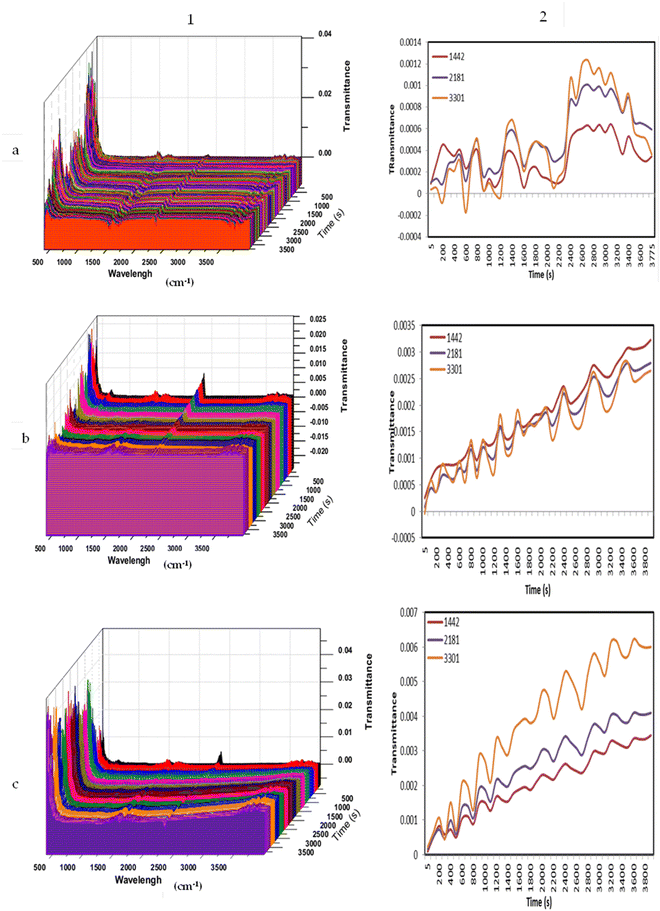 |
| | Fig. 7 3D-FTIR of Afrormosia heat-treated under air, (1) 3D-FTIR, (2) evolution of evolved gas components with time, (a) 160 °C, (b) 180 °C, (c) 200 °C. | |
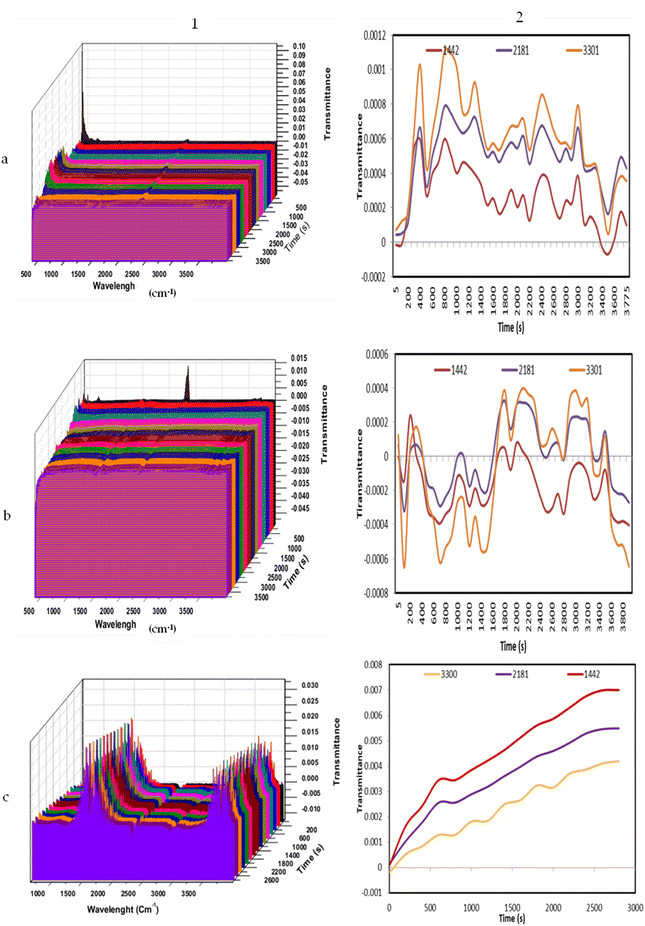 |
| | Fig. 8 3D-FTIR of Newtonia heat-treated under air, (1) 3D-FTIR, (2) evolution of evolved gas components with time, (a) 160 °C, (b) 180 °C, (c) 200 °C. | |
 |
| | Fig. 9 3D-FTIR of Afrormosia heat-treated under palm oil, (1) 3D-FTIR, (2) evolution of evolved gas components with time, (a) 160 °C, (b) 180 °C, (c) 200 °C. | |
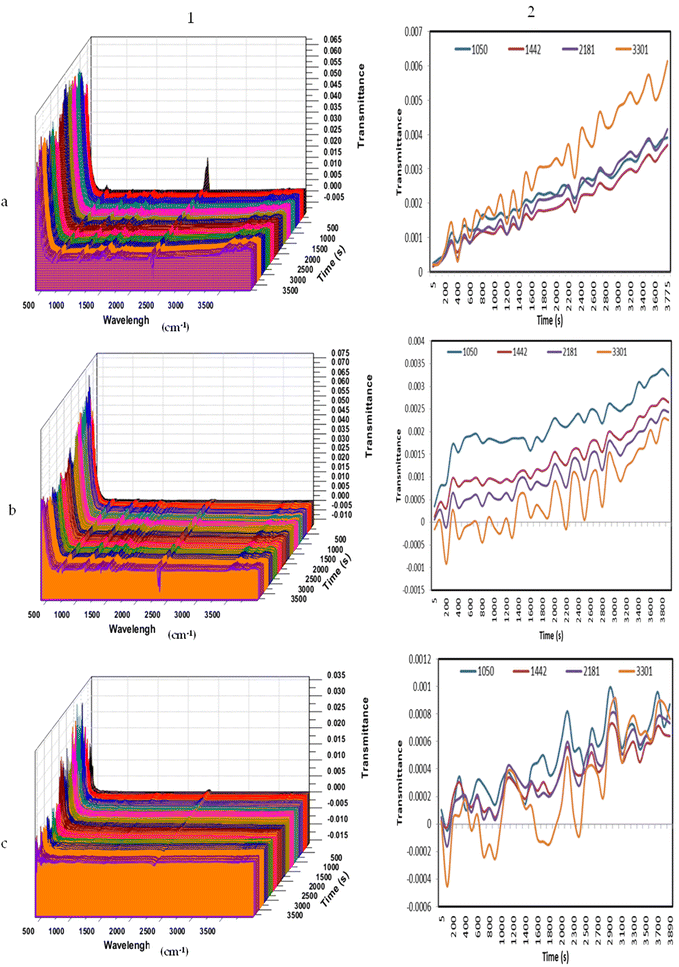 |
| | Fig. 10 3D-FTIR of Newtonia heat-treated under palm oil, (1) 3D-FTIR, (2) evolution of evolved gas components with time, (a) 160 °C, (b) 180 °C, (c) 200 °C. | |
Table 3 Correspondence between wave numbers and structural wood polymers
| Compounds |
Bonding type |
Number of waves (cm−1) |
Structural polymers |
| H2O |
O–H |
3300–3750 |
Hemicelluloses, cellulose |
| CH3COOH |
C–O (esthers); β-O-4 (lignin) |
1050 |
Lignin, hemicellulose |
| CO |
C![[triple bond, length as m-dash]](https://www.rsc.org/images/entities/char_e002.gif) O O |
2181 |
Hemicellulose |
| H2O |
O–H (alcohol) |
1442 |
Hemicellulose, cellulose |
3.3. Effect of heat treatment on the mechanical properties
3.3.1. MOR. The results of the statistical analyses relating to the modulus of rupture (MOR) are presented in Table 4. It can be seen from the latter table that there is no equality of mean values between samples heat-treated in oil and those heat-treated in air; in fact, the first group of samples generally has higher moduli of rupture than the second group of samples (Fig. 11). Thermogravimetric analysis provides an explanation for this observation, as it showed that the residual masses of wood samples treated under palm oil were generally greater than those of samples treated under air; in other words, the loss of wood mass is greater when wood is treated under air; there is less vacuum in the wood treated under palm oil compared to that treated under air, which justifies this result. The modulus of rupture of Afrormosia samples and the modulus of rupture of Newtonia samples are not equal on average (Table 4); on the other hand, Fig. 11 shows that the MOR of Afrormosia is always higher than that of Newtonia;17 this is justified by the fact that the density of Afrormosia is greater than that of Newtonia.29 As far as the effect of temperature on MOR is concerned, there is no overall statistical difference between the mean MOR values of wood samples treated at 160 °C and the mean MOR values of control samples (Table 4); on the other hand, the inegalitarian test of the means referred to the radial direction (MORR) for the latter two groups of samples is significant, and Fig. 11 shows that the highest values of modulus of rupture in the radial direction are those of the specimens treated at 160 °C; similarly, the test of inequality of means in the tangential direction (MORT) for these two groups of samples is significant, and Fig. 11 shows that the highest values of modulus of rupture in the tangential direction are those of the control specimens. For temperatures above 160 °C, the modulus of elasticity decreases with increasing treatment temperature (Table 4 and Fig. 11), irrespective of the wood direction chosen;30 indeed, we have shown through TGA-FTIR analysis that the air and palm oil used to heat-treat Afrormosia and Newtonia wood at 160 °C resulted in the predominant degradation and loss of mass of hemicelluloses.31,32
Table 4 Statistical analysis results of MORa
| |
Temperature |
Control |
160 °C |
180 °C |
200 °C |
Control |
160 °C |
180 °C |
200 °C |
| S: The test of inequality of means is significant; NS: the test of inequality of means is not significant; *: the test of inequality of means in the tangential and radial directions is significant; +: the test of the inequality of the means of the oil-treated and air-treated samples is significant. |
| |
|
Afrormosia heat-treated under air |
Newtonia heat-treated under air |
| Afrormosia heat-treated under air |
Control |
— |
+NS* |
+S* |
+S* |
+S* |
— |
— |
— |
| 160 °C |
— |
— |
+S* |
+S* |
— |
+S* |
— |
— |
| 180 °C |
— |
— |
— |
+S* |
— |
— |
+S* |
— |
| 200 °C |
— |
— |
— |
— |
— |
— |
— |
+S* |
| Newtonia heat-treated under air |
Control |
— |
— |
— |
— |
— |
+NS* |
+S* |
+S* |
| 160 °C |
— |
— |
— |
— |
— |
— |
+S* |
+S* |
| 180 °C |
— |
— |
— |
— |
— |
— |
— |
+S* |
![[thin space (1/6-em)]](https://www.rsc.org/images/entities/char_2009.gif) |
| |
|
Afrormosia heat-treated under oil |
Newtonia heat-treated under oil |
| Afrormosia heat-treated under oil |
Control |
— |
+NS* |
+S* |
+S* |
+S* |
— |
— |
— |
| 160 °C |
— |
— |
+S* |
+S* |
— |
+S* |
— |
— |
| 180 °C |
— |
— |
— |
+S* |
— |
— |
+S* |
— |
| 200 °C |
— |
— |
— |
— |
— |
— |
— |
+S* |
| Newtonia heat-treated under oil |
Control |
— |
— |
— |
— |
— |
+NS* |
+S* |
+S* |
| 160 °C |
— |
— |
— |
— |
— |
— |
+S* |
+S* |
| 180 °C |
— |
— |
— |
— |
— |
— |
— |
+S* |
 |
| | Fig. 11 MOR of Afrormosia and Newtonia as a function of temperature and treatment media. (Top): treatment under air, (bottom): treatment under palm oil, (left): MORT, (right) MORR. | |
3.3.2. MOE. In contrast to MOR, the modulus of elasticity (MOE) in radial (MOER) and tangential directions (MOET) of the samples treated under palm oil is lower than the modulus of elasticity of the samples treated under air (Table 5 and Fig. 12). In fact, although the residual mass of the samples treated under palm oil is higher than that of the samples treated under air, 3D FTIR analysis shows that the 1050 cm−1 wavelength is far more concentrated in samples treated with palm oil than in those treated with air; this wavelength is associated with the emission of acetic acid from the cleavage of acetyl groups (deacetylation) in lignin and hemicellulose.33 On the other hand, from a statistical point of view, up to 200 °C, temperature has no significant influence on the modulus of elasticity (Table 5), although intuitively it would seem that the said modulus increases slightly when the wood is treated between 160 °C and 180 °C (Fig. 12).34 This could be due to the crystallization of amorphous cellulose, which virtually offsets the degradation of cellulose as described above.19 Furthermore, the MOE of Afrormosia is always higher than the MOE of Newtonia (Table 5 and Fig. 12).
Table 5 Statistical analysis results of MOEa
| |
Temperature |
Control |
160 °C |
180 °C |
200 °C |
Control |
160 °C |
180 °C |
200 °C |
| S: The test of inequality of means is significant; NS: the test of inequality of means is not significant; *: the test of inequality of means in the tangential and radial directions is significant; +: the test of the inequality of the means of the oil-treated and air-treated samples is significant. |
| |
|
Afrormosia heat-treated under air |
Newtonia heat-treated under air |
| Afrormosia heat-treated under air |
Control |
— |
+NS* |
+NS* |
+NS* |
+NS* |
— |
— |
— |
| 160 °C |
— |
— |
+NS* |
+NS* |
— |
+NS* |
— |
— |
| 180 °C |
— |
— |
— |
+NS* |
— |
— |
+NS* |
— |
| 200 °C |
— |
— |
— |
— |
— |
— |
— |
+NS* |
| Newtonia heat-treated under air |
Control |
— |
— |
— |
— |
— |
+NS* |
+NS* |
+NS* |
| 160 °C |
— |
— |
— |
— |
— |
— |
+NS* |
+NS* |
| 180 °C |
— |
— |
— |
— |
— |
— |
— |
+NS* |
![[thin space (1/6-em)]](https://www.rsc.org/images/entities/char_2009.gif) |
| |
|
Afrormosia heat-treated under oil |
Newtonia heat-treated under oil |
| Afrormosia heat-treated under oil |
Control |
— |
+NS* |
+NS* |
+NS* |
+NS* |
— |
— |
— |
| 160 °C |
— |
— |
+NS* |
+NS* |
— |
+NS* |
— |
— |
| 180 °C |
— |
— |
— |
+NS* |
— |
— |
+NS* |
— |
| 200 °C |
— |
— |
— |
— |
— |
— |
— |
+NS* |
| Newtonia heat-treated under oil |
Control |
— |
— |
— |
— |
— |
+NS* |
+NS* |
+NS* |
| 160 °C |
— |
— |
— |
— |
— |
— |
+NS* |
+NS* |
| 180 °C |
— |
— |
— |
— |
— |
— |
— |
+NS* |
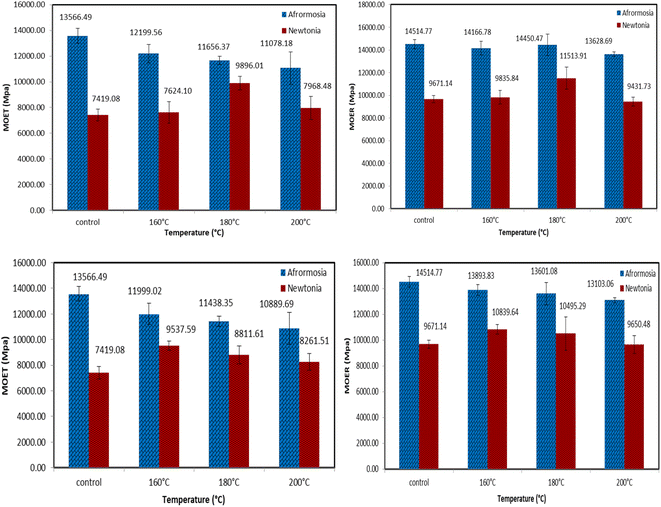 |
| | Fig. 12 MOE of Afrormosia and Newtonia as a function of temperature and treatment media. (Top): air treatment, (bottom): palm oil treatment, (left): MOET, (right): MOER. | |
4. Conclusions
The main objective of this research was to study the influence of heat treatment media on odorous constituents, chemical decomposition, Modulus of Rupture (MOR) and Modulus of Elasticity (MOE) of Afrormosia and Newtonia wood heat treated under air and palm oil. Results showed that 180 °C is the best of the three temperatures that we used for treatment, which provides optimal reduction of VOCs with unpleasant odors of Afrormosia by air and palm oil heat treatment, but palm oil heat treatment gives better results. Air heat treatment is not particularly suitable for improving the quality of odors emitted by Newtonia. The heat treatment under oil reduces the unpleasant odors of the constituents of Newtonia wood better than the heat treatment under air and it is 200 °C, which seems to be the optimal temperature for this case. The residual mass of wood treated with palm oil is higher than the residual mass of wood treated with air because palm oil acts as a barrier, limiting the heat-induced degradation of structural polymers; indeed, concentrations of H2O, CH3COOH and CO in palm-oil-treated wood were lower than in air-treated wood. Whatever the wood species, heat treatment under air of Afrormosia and Newtonia tends to degrade hemicelluloses in greater quantities than other structural polymers, and this trend increases with temperature. The MOR of palm oil-heat-treated wood was higher than the MOR of air-heat-treated wood. The MOE of palm air heat-treated wood was higher than the MOE of palm oil heat-treated wood. These results highlight the relevance of the treatment medium in the effectiveness of using heat treatment to improve wood odor quality.
Data availability
The data that allowed for the writing of this article are available from the Wood Science and Technology department/School of Material Science and Technology of the Beijing Forestry University.
Author contributions
Conceptualization, Lionnel Frederique Bidzanga Bessala and Zhengbin He; methodology Zhengbin He; Songlin Yi and Zhenyu Wang; formal analysis, Lionnel Frederique Bidzanga Bessala; investigation, Jingjing Gao and Lionnel Frederique Bidzanga; data curation, Lionnel Frederique Bidzanga Bessala; writing – original draft preparation, Lionnel Frederique Bidzanga Bessala; writing – review and editing, Zhenyu Wang; supervision, Songlin Yi. All authors have read and agreed to the published version of the manuscript.
Conflicts of interest
There are no conflicts to declare.
Acknowledgements
This article was supported and funded by the Fundamental Research Funds for the Central Universities (No. BLX202235), the Fundamental Research Funds for the Central Universities (BFUKF202315) and the China Scholarship Council (CSC).
References
- Cirad. Tropix 7.0, 2022, Available online: https://tropix.cirad.fr/FichiersComplementaires/EN/Africa/AFRORMOSIA.pdf accessed on 12 November.
- Z. Liu and J. C. Little, Materials Responsible for Formaldehyde and Volatile Organic Compound (VOC) Emissions, Woodhead Publishing Limited, 2012, pp. 76–121 Search PubMed.
- Y. Huang, Y. Zhang, Y. Qi, Y. Yu and W. Yu, Identification of odorous constituents of bamboo during thermal treatment, Constr. Build. Mater., 2019, 203, 104–110 CrossRef CAS.
- C. Jiang, D. Li, P. Zhang, J. Li, J. Wang and J. Yu, Formaldehyde and volatile organic compound (VOC) emissions from particleboard: Identification of odorous compounds and effects of heat treatment, Build Environ., 2017, 117, 118–126 CrossRef.
- D. H. Peters, A. Garg, G. Bloom, D. G. Walker, W. R. Brieger and M. H. Rahman, Poverty and access to health care in developing countries, Ann. N. Y. Acad. Sci., 2008, 1136, 161–171 CrossRef PubMed.
- L. Todaro, M. D'Auria, F. Langerame, A. Salvi and A. Scopa, Surface characterization of untreated and hydro-thermally pre-treated Turkey oak woods after UV-C irradiation, Surf. Interface Anal., 2015, 47, 206–215 CrossRef CAS.
- A. Azadeh, K. Ghavami and J. J. García, The influence of heat on mechanical properties of Dendrocalamus giganteus bamboo, J. Build. Eng., 2021, 43, 102613 CrossRef.
- K. Candelier, S. Dumarçay, A. Pétrissans, P. Gérardin and M. Pétrissans, Comparison of mechanical properties of heat treated beech wood cured under nitrogen or vacuum, Polym. Degrad. Stab., 2013, 1–4, DOI:10.1016/j.polymdegradstab.2013.05.026.
- D. Kacíková, F. Kacík, I. Cabalová and J. Durkovic, Effects of thermal treatment on chemical, mechanical and colour traits in Norway spruce wood, Bioresour. Technol., 2013, 144, 669–674, DOI:10.1016/j.biortech.2013.06.110.
- J. Zhou, C. Hu, S. Hu, H. Yun, G. Jiang and S. Zhang, Effects of temperature on the bending performance of wood-based panels, BioResources, 2012, 7(3), 3597–3606 Search PubMed.
- Y. Kubojima, T. Okano and M. Ohta, Bending strength of heat-treated wood, J. Wood Sci., 2000, 46, 8–15 CrossRef.
- J. Shi, D. Kocaefe and J. Zhang, Mechanical behaviour of Quebecwood species heat-treated using ThermoWood process, Holz Roh- Werkst., 2007, 65, 255–259 CrossRef.
- S. Korkut, M. Akgü and T. Dündar, The effects of heat treatment on some technological properties of Scots pine (Pinus sylvestris L.) wood, Bioresour. Technol., 2008, 99, 1861–1868 CrossRef CAS PubMed.
- M. Borrega and P. Kärenlampi, Mechanical behavior of heat-treated spruce (Picea abies) wood at constant moisture content and ambient humidity, Eur. J. Wood Wood Prod., 2008, 66(1), 63–69 CrossRef CAS.
- E. D. Tomak, D. Ustaomer and S. Yildiz, Pesman E Changes in surface and mechanical properties of heat treated wood during natural weathering, Measurement, 2014, 53, 30–39, DOI:10.1016/j.measurement.2014.03.018.
- I. Burget, A. Bernasconi, K. J. Niklas and D. Eckstein, L'influence des rayons sur l'anisotropie élastique transversale dans le bois vert des arbres à feuilles caduques, Holzforschung, 2001, 55, 449–454 Search PubMed.
- E. Foadieng, W. C. M. Fouotsa, T. U. G. Azeufack, P. K. Talla and M. Fogue, Mechanical Behavior of Pericopsis elata Relative to Age during Growth, Adv. Mater. Sci. Eng., 2021, 4374181 Search PubMed.
- X. Hao, Q. Wang, Y. Wang, X. Han, C. Yuan, Y. Cao, Z. Lou and Y. Li, The effect of oil heat treatment on biological, mechanical and physical properties of bamboo, J. Wood Sci., 2021, 67, 1–14 CrossRef.
- J. Xu, Y. Zhang, Y. Shen, C. Li, Y. Wang, Z. Ma and W. Sun, New perspective on wood thermal modification: relevance between the evolution of chemical structure and physical-mechanical properties, and online analysis of release of VOCs, Polymers, 2019, 11, 1145, DOI:10.3390/polym11071145.
- R. Liu, C. Wang, A. Huang and B. Lv, Characterization of Odors of Wood by Gas Chromatography-Olfactometry with Removal of Extractives as Attempt to Control Indoor Air Quality, Molecules, 2018, 23, 203 CrossRef PubMed.
- L. F. B. Bessala, J. Gao, Z. He, Z. Wang and S. Yi, Emission of Volatile Organic Compounds from the Heat Treatment of Afrormosia and Newtonia Wood: Effects of Air and Palm Oil Heat Media, Forests, 2023, 14(5), 1062 CrossRef.
- F. Naidir, R. Yunus, T. I. M. Ghazi and I. Ramli, Synthesis of epoxidized palm oil-based Trimethylolpropane ester by in situ epoxidation method, Pertanika J. Sci. & Technol., 2012, 20(2), p331 Search PubMed.
- A. Manninen, P. Pasanen and J. Holopainen, Comparing the VOC emissions between air-dried and heat-treated Scots pine wood, Atmos. Environ., 2002, 36, 1763–1768 CrossRef CAS.
- A. Florence, Contribution à l'etude des traitements thermiques du bois jusqu'a 300 °C : transformations chimiques et caracterisations physico-chimiques, Ecole nationale superieure des mines de saint-etienne, 1993 Search PubMed.
- J. R. Rajohnson, R. Guyonnet and B. Guilhot, Experimental study and modeling of the wood retification, Proceedings of the ACOFOP III Symposium, Elsevier Science Publishers, Paris, 1994, vol. 36, pp. 227–234 Search PubMed.
- M. K. Dubey, S. Pang and J. Walker, Oil uptake by wood during heat-treatment and post-treatment cooling, and effects on wood dimensional stability, Eur. J. Wood Wood Prod., 2012, 70, 183–190 CrossRef CAS.
- A. Sikora, F. Kacik, M. Gaff, V. Vondrova, T. Bubenikova and I. Kubovsky, Impact of thermal modification on color and chemical changes of spruce and oak wood, J. Wood Sci., 2018, 64, 406–416 CrossRef CAS.
- M. Wu, J. Jin, C. Cai, J. Shi and X. Xing, et al., Effects of impregnation combined heat treatment on the pyrolysis behavior of poplar wood, PLoS One, 2020, 15(3), e0229907 CrossRef CAS PubMed.
- L. F. B. Bessala, J. Gao, Z. He, Z. Wang and S. Yi, Effects of heat treatment on color, dimensional stability, hygroscopicity and chemical structure of Afrormosia and Newtonia wood: A comparative study of air and palm oil medium, Polymers, 2023, 15, 774 CrossRef CAS PubMed.
- N. T. Mascia, D. E. Kretschmann and R. Vilela, Evaluation of wood modulus of rupture and modulus of elasticity in the radial and tangential directions in bending and reliability analysis, Eur. J. Wood Wood Prod., 2022, 80(3), 597–610 CrossRef CAS.
- D. Wang, F. Fu and L. Lin, Molecular-level characterization of changes in the mechanical properties of wood in response to thermal treatment, Cellulose, 2022, 29, 3131–3142, DOI:10.1007/s10570-022-04471-3.
- X. Wang, X. Chen, X. Xie, Y. Wu, L. Zhao, Y. Li and S. Wang, Effects of thermal modification on the physical, chemical and micromechanical properties of Masson pine wood (Pinus massoniana Lamb.), Holzforschung, 2018, 72(12), 1063–1070, DOI:10.1515/hf-2017-0205.
- R. Wahab, M. S. Sulaiman, H. W. Samsi, R. S. M. Ghani and N. Mokhtar, The effectiveness of oil-heat treatment in the main chemical constitutes of planted 15-year-old acacia hybrid, Asian J. Sci. Technol., 2020, 11, 10692–10699 Search PubMed.
- I. F. Suri, B. D. Purusatama and J. H. Kim, et al., Comparison of physical and mechanical properties of Paulownia tomentosa and Pinus koraiensis wood heat-treated in oil and air, Eur. J. Wood Wood Prod., 2022, 80, 1389–1399, DOI:10.1007/s00107-022-01840-4.
|
| This journal is © The Royal Society of Chemistry 2024 |
Click here to see how this site uses Cookies. View our privacy policy here.  Open Access Article
Open Access Article ,
Jingjing Gao,
Zhengbin He,
Zhenyu Wang* and
Songlin Yi*
,
Jingjing Gao,
Zhengbin He,
Zhenyu Wang* and
Songlin Yi*
![[thin space (1/6-em)]](https://www.rsc.org/images/entities/char_2009.gif) :
:![[thin space (1/6-em)]](https://www.rsc.org/images/entities/char_2009.gif) 1) and an EI power and electron energy of 70 eV. The mass range that has been used for the mass selective detector is 45–400 m/z. The chromatograms obtained were compared to those in the NIST 2011 database to determine the categories and proportions of the related compounds. For this purpose, two main parameters were used: the retention time (RT) and the percentage of peak area (% A).
1) and an EI power and electron energy of 70 eV. The mass range that has been used for the mass selective detector is 45–400 m/z. The chromatograms obtained were compared to those in the NIST 2011 database to determine the categories and proportions of the related compounds. For this purpose, two main parameters were used: the retention time (RT) and the percentage of peak area (% A).
![[thin space (1/6-em)]](https://www.rsc.org/images/entities/char_2009.gif)
![[thin space (1/6-em)]](https://www.rsc.org/images/entities/char_2009.gif)


![[thin space (1/6-em)]](https://www.rsc.org/images/entities/char_2009.gif)
![[thin space (1/6-em)]](https://www.rsc.org/images/entities/char_2009.gif)






![[triple bond, length as m-dash]](https://www.rsc.org/images/entities/char_e002.gif) O
O![[thin space (1/6-em)]](https://www.rsc.org/images/entities/char_2009.gif)
![[thin space (1/6-em)]](https://www.rsc.org/images/entities/char_2009.gif)




